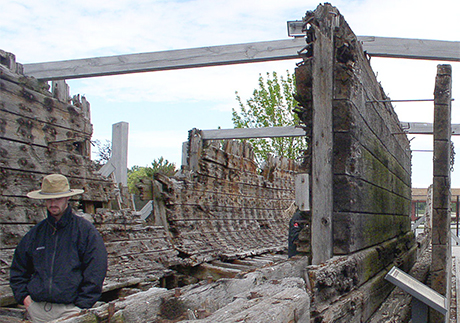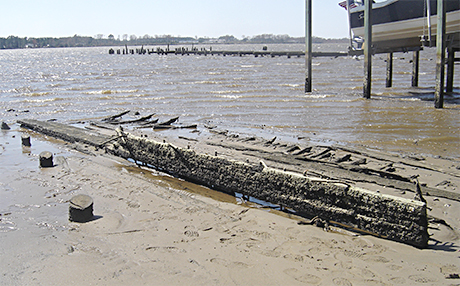ECU's 2006 Fall Field School
Project Journal
26 September 2006
By Michelle Damian

We have settled into a rhythm to our work on the site. At the beginning of the day we designate a rotation, scheduling time for everyone to be mapping their sections and to be dredging or sifting the dredge spoil (we found another marble today! See my last entry (Day 10) for my musings on marbles). We’re seeing some real progress – as of the end of the day, our maps for six out of the fourteen total sections have been completed. With only three days left in the field, this is a good sign!
We’ve mentioned several times that the Padgett vessel is a centerboard wreck site, but I don’t think we’ve explained exactly what that is. Centerboard vessels became widely used along the East Coast of the United States in the late eighteenth and early nineteenth centuries. Shallow waters required a flat-bottomed sailing vessel to prevent running aground. However, coastal craft also ventured out into more open, deeper waters. Without any kind of keel – the “backbone” of the vessel that usually protrudes into the water – the boat would have no inherent drag and would be more likely to be blown in whichever direction the wind pushed it. The centerboard was developed as a compromise. A flat-bottomed vessel would have a movable board sandwiched in a trunk alongside the keelson. When navigating in shallow waters, the board would be pulled up within the boat so as not to interfere with maneuverability. In open waters, the centerboard would be lowered to increase resistance and help to both steer and balance the boat.

Comparison of two types of centerboard schooners. Above is a larger centerboard vessel that once sailed on the Great Lakes. Below is the centerboard of our vessel, completely exposed during a "blowout" in the early spring of 2006. Centerboard sizes were as varied as the vessels that needed them and were constructed to suit a vessel's purpose and sailing environment.

During our summer field school in Wisconsin, we had the opportunity to see the remnants of a large centerboard vessel that was discovered during dredging in Lake Michigan. Though the Padgett vessel that we’re working on now is nowhere near the size of the one in Wisconsin, the photo shows how large the centerboard trunk could get in larger ships. The centerboard itself has been pulled out and rests to the right of the trunk. Just for comparison, the centerboard trunk of the Padgett vessel is probably only about 18 inches tall.
One of the reasons for examining the centerboards in such detail is to learn more about local watercraft and how they were built. Different regions had different styles of construction. We will look at the centerboard, at the types of scarfing (ways to join pieces of wood together), at any tool marks we might find, and at the patterns of all those fasteners for clues as to how this vessel was put together. This will tell us more about where it might have been constructed. If it was from North Carolina, we might then look at how similar craft were used locally to discover what our vessel’s role could have been in the larger picture. If it was not of local construction, then we might begin to investigate how it got to Washington, who possibly brought it there, and why. Each answer that we find leads us to more questions… and trying to find out the rest of the story is part of the fun of these explorations.
For more information you can visit the ECU website at:
http://www.ecu.edu/maritime/index.htm
Return to Project Journal home page.

